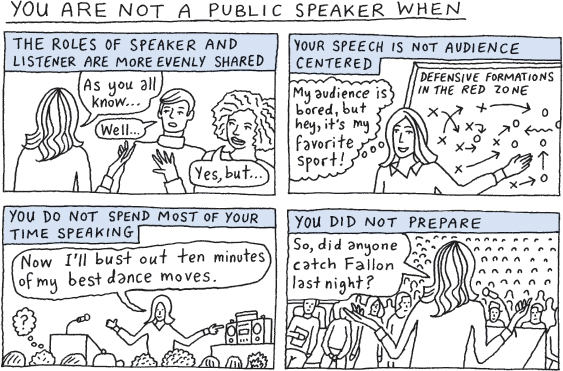WHAT IS PUBLIC SPEAKING?
Printed Page 6
What is public speaking, exactly? When done effectively, this activity has several characteristics that distinguish it from other types of communication.
Public speaking features communication between a speaker and an audience In public speaking, the speaker does most of the talking, while the audience primarily listens. However, that does not mean audience members don’t respond to what they’re hearing. Audience members may smile, frown, or look puzzled. Talented speakers recognize these signals and modify their message if needed—for example, clarifying a point when they notice confused expressions on their listeners’ faces. Audience members might even respond with more than just silent facial expressions. For instance, they may applaud the speaker or shout out words of encouragement and appreciation if they’re pleased with or excited by the speaker’s message. Or they may boo or heckle the speaker if they disagree with the message. However, in public speaking, even the most energetic interjections are usually brief. For the majority of the speech, the speaker “has the floor.”

Public speaking is audience centered. In public speaking, the presenter chooses his or her message with the audience’s interests and needs in mind. Good speakers consider what topic would be appropriate for their audience on a particular occasion. They also develop their message in a way that their audience will find interesting and understandable.
For example, suppose you recently got a job as a product developer at a furniture company. You’ve asked to meet with members of your company’s management team to discuss a new line of dorm furniture that you’d like to launch. At the meeting, you want to persuade your listeners to approve funding for a proposed line. In preparing your speech, you think about what members of the management team care about most: the company’s profitability—its ability to increase revenues while reducing costs. So you develop explanations for how the proposed campaign will enhance profitability (“This new line will increase sales by 10 percent over the next two quarters while cutting our expenses by 5 percent—leading to a 6 percent increase in profitability”). You make sure to avoid sales-style language, such as “This new design is bold and provocative,” because you know that such language will hold little interest for your business-oriented listeners.
Public speaking emphasizes the spoken word. Any speaker can supplement his or her speech with pictures, charts, videos, handouts, objects, or even a live demonstration. However, public speakers devote most of their time to speaking to their audience. The spoken word plays the central role in their message, though speakers use gestures, posture, voice intonation, eye contact, other types of body language, and even presentation aids to heighten the impact of their words.
Public speaking is usually a prepared presentation. Few public speakers simply walk up to the lectern or podium and make up their talk as they go. The best speakers choose their topic in advance, carefully consider what they might say about that topic, and then select the best ideas for the audience they will be addressing. They organize those ideas, choose their words carefully, and practice delivering the speech before the big day. Even people who suspect that they may be called on to deliver an impromptu speech—for example, at a community-service awards dinner—know how to quickly piece together a few comments as they step to the front of the room.
